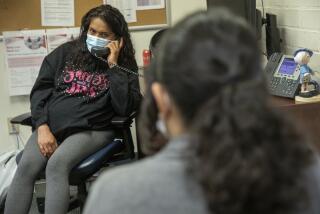Covered California enrollment website may not be ready by Oct. 1
- Share via
Less than six weeks before the launch of a major healthcare overhaul, California officials are scrambling to get their online enrollment system ready in time.
Thursday, the state’s new health insurance marketplace said its website may not be fully operational Oct. 1 when consumer enrollment begins under the Affordable Care Act. But officials said they would know more after the results of key computer tests early next month.
This month, Oregon said its online enrollment wouldn’t be ready Oct. 1 and it would take only paper and phone applications from consumers for the first few weeks.
Full coverage: Healthcare law comes to California
“We have not made that call yet,” said Peter Lee, executive director of Covered California, which is implementing the federal health law in the state. If online enrollment isn’t immediately available, Lee said, there would be other ways to sign up through call centers, enrollment counselors and agents before coverage kicks in Jan. 1. “The date we care about is Jan. 1 when coverage takes effect.”
Still, there is concern that even a short postponement in online enrollment may turn off some potential participants. But officials think a minimal delay wouldn’t significantly hamper sign-ups. Open enrollment in the insurance exchange will run from Oct. 1 to March 31 in the first year.
But some provisions of the health law have already been delayed at the federal level, and health-policy experts say more missed deadlines could embolden critics and further undercut tepid public support for the controversial overhaul.
“In the current environment, any postponement will be fodder for political attacks,” said Joel Ario, a former federal health official and a managing director at Manatt Health Solutions, a Washington consulting firm. “I think states will be very careful not to have delays unless they have to. These political fights don’t help.”
The state is trying to reach as many as 5 million Californians who are uninsured or don’t receive health insurance through their employers. The goal for exchange enrollment is 1.4 million by December 2014. Another 1.4 million Californians may be eligible for an expansion of Medi-Cal, the state’s Medicaid program for the poor.
Keith Ketcher, an outside project manager working on the state computer system, told the Covered California board Thursday that “there is work that remains to validate that the enrollment process is ready to go in October.… We will know in the coming weeks what our progress is.”
Even before Thursday’s discussion, officials had already dialed back some of the expectations for the exchange website.
Early on, Lee vowed that signing up for health coverage on the state website would be as easy as buying a book on Amazon.com. But, at town hall meetings across the state, Lee acknowledges it may not be that simple after all, comparing it now to filing an income tax return using software such as TurboTax.
Another issue for California and 15 other states building their own online marketplaces is that they must verify people’s income, Social Security numbers and other information with a federal data hub that’s been running behind schedule.
A government audit this month raised concerns about whether the federal system would complete testing for data security in time for an Oct. 1 launch. The testing is crucial to show that the system can safely transmit tax information and other data among state exchanges and federal agencies.
Citing that audit, Republicans in Congress have questioned whether people’s personal and financial information will be secure in these government systems given the lack of testing. Federal officials say the data hub remains on track.
California officials said they continue to make progress on a number of fronts.
The state expects to publish an online calculator early next month through which consumers can compare prices of specific health plans. Covered California’s current calculator gives general rates as well as the amount of federal subsidies that consumers may qualify for based on their income.
Individuals earning less than $46,000 a year and families below $94,000 annually may qualify for subsidies. In California, individuals earning less than $16,000 can get coverage through an expansion of Medi-Cal.
Two service centers are expected to start taking general calls next week. Nearly 800 people have taken a state exam to become certified for outreach and education work. Officials said 95% passed the exam with a score of 80% or higher. Covered California also has plans to provide training and certification for about 9,000 insurance agents.
A state advertising campaign will start in selected markets next month with a broader rollout in October. A Field Poll released this week found that just 25% of California voters younger than 65 said they had heard a lot or some about Covered California. Awareness was even lower among the uninsured: Only 18% of those voters said they knew much about the new state-run market.
Twitter: @chadterhune
More to Read
Inside the business of entertainment
The Wide Shot brings you news, analysis and insights on everything from streaming wars to production — and what it all means for the future.
You may occasionally receive promotional content from the Los Angeles Times.











